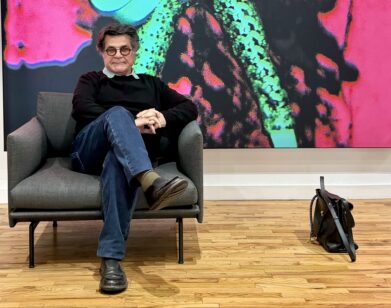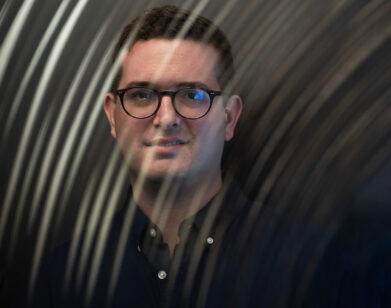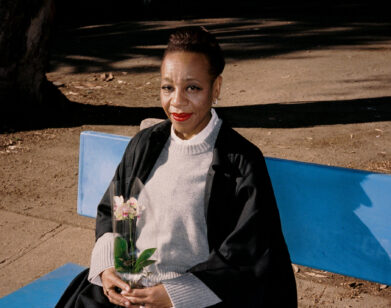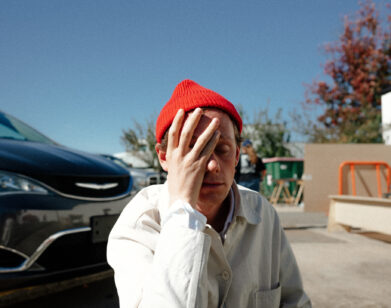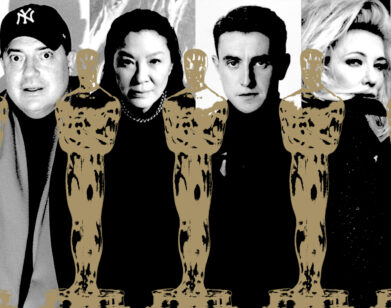CLASS WARFARE
Ruben Östlund Doesn’t Hate Rich People
When Triangle of Sadness took home the top prize at Cannes, director Ruben Östlund began his speech by leading the tuxedoed audience in a primal scream. More civilly, at its festival premiere a week earlier, the film yielded an enthusiastic eight-minute standing ovation from the same well-dressed elites Östlund so gleefully pillories in his work. His previous two releases, The Square (which also won the Palme d’Or) and Force Majeure, are also biting satires that turn a mirror onto the ruling class—a group with whom Östlund, admittedly, rubs elbows. Triangle of Sadness, which he considers a companion piece of sorts to those two films, is a nearly two-and-a-half-hour spectacle of conspicuous consumption, bad behavior, and bodily fluids that provokes nausea and uproarious laughter, sometimes in the same scene. The 48-year-old Swedish filmmaker approached Triangle of Sadness with an anything-goes mentality. The absurdity peaks when the megayacht captained by a drunken, Marxist Woody Harrelson runs aground in a sudden volatile storm, causing the ultra-rich passengers to projectile vomit gold-dusted gelee and sea urchin all over the ship’s starched white table settings. It’s a disgustingly hilarious 15-minute scene that left theatergoers shrieking, laughing, and tweeting (and was even memorialized on a T-shirt by the Swedish design house CDLP). In the run up to an awards season where Academy members’ stomachs—and notoriously conservative sensibilities—will be put to the test, we sat down with Östlund to discuss class commentary, his appreciation for participatory American audiences, and to find out what, if anything, grosses him out.
———
CAITLIN LENT: Hi Ruben! I’ll start off: where are you? What are you up to today?
RUBEN ÖSTLUND: I’m in Mallorca in Spain.
LENT: That’s so nice.
ÖSTLUND: I’m in the car with my wife and my son and we have been in Palma, in the countryside of Mallorca.
LENT: Lovely. Are you relaxing in the run up to awards season?
ÖSTLUND: Well, we’re actually having a one week break. I was just in Rome and Milan for the Italian release, then we’re going to Marrakesh for the festival [Marrakech International Film Festival]. So it’s a combination of work and taking a little holiday, but it’s very much about touring with the film.
LENT: Well, let’s get into the film. I loved it and I want to pick your brain about it. You won your second Palme d’Or. How does it feel to you to have received this sort of institutional recognition from the very same elite class of people you’re skewering in Triangle of Sadness?
ÖSTLUND: It feels great. I want to confront the audience that is part of the cinema world, the cultural elite that I’m part of myself. I don’t really see any reason to confront a social group other than the one that I’m connected to. I want to confront myself, to look in a mirror and ask questions.
LENT: What would you say to people who call the ultra-rich an easy target?
ÖSTLUND: I agree in some sense, of course. But the intention that I had when I made the film was never to portray the rich people as especially mean or egoistic. I didn’t want to go into that conventional way of portraying rich people. I would rather have the audience question a certain kind of structure, and how the society is built. But I’m mean to all of the characters in my films, so of course I’m going to be a little mean to the rich people. But I tried to show that our behavior comes from which position we have in a financial structure and our behavior is going to change if we have been on the bottom and we get to the top. I wanted to step back and look at it more from a behavioral point of view.
LENT: I love that idea of critiquing the structures rather than individuals. That’s something that I’ve seen in many of your films.
ÖSTLUND: I tried to make the arms dealers couple the most sympathetic characters that I’ve ever made. So I wanted them to be nice to all the crew and to the other passengers. And they’re still in love after all these years, but then you get to know that they’ve made all their money selling landmines. One thing that I’m dealing with is that people just assume that I’m portraying rich people as not so nice. But actually, I would like to say, “Please watch the film again” if that’s the case, because I think I’m quite nice to rich people.
LENT: Elsewhere, you’ve talked about how many test screenings you did for the film. Did you make any changes according to the feedback you received?
ÖSTLUND: First of all, I consider Triangle of Sadness a movie that you should see in the cinema, and that changes how you cut it. If you cut something where you have an audience that is 50 people or more in one room, it’ll change the dynamics of the film. When I was in the editing process, I did five different screenings just to try to see if the audience is concentrating, or if something is too long, and how they’re reacting. I don’t really ask them any questions afterwards, it’s only about trying to feel the rhythm when it comes to the audience. We directors have to understand that the film should work in the cinema. It’s a completely different setup than when you’re watching something on an individual screen by yourself.
LENT: Absolutely. I watched it on my laptop at home and thought it was wonderful, but all my friends who’ve seen it say, “I saw it in a packed theater and everyone was screaming and yelling and laughing and crying,” so I really want to have that experience with the film. I’m also curious, do you trust your audience?
ÖSTLUND: I definitely trust my audience. I trust my audience more than I trust film critics because I feel that film critics so often want to be on top of the game, they want to be smarter than the film. But an audience just comes in and reacts and goes with the flow. I don’t look at them any differently than I look at myself. I hope that they enjoy the same kind of humor and content that I enjoy. I wanted to create a very entertaining movie, take the best parts of the American film industry, because the American film industry is so great at including the audience, and then take the best part of the European film tradition of trying to discuss something about society, and provoke the audience. I wanted to create a rollercoaster ride for adults.
LENT: And you do it.
ÖSTLUND: I basically only think about what I would enjoy because I don’t separate myself from the audience.
LENT: It seems like schadenfreude is a big part of this film. Do you thrive on schadenfreude and do you think your audiences do?
ÖSTLUND: When I watch cinema, I like to be pushed into a corner and challenged. I enjoy watching awkward moments. I don’t want to punish my audience, I don’t want them to suffer, or anything. These are just the things that I enjoy watching myself. And I like to watch awkward social situations. I was a little bit inspired by a combination of Michael Haneke and Larry David.
LENT: Those are fantastic influences. I read that you had worked on ski resorts prior to making Force Majeure, and then with The Square you had done some art handling with Kalle Boman. Was there a point in your career where you started to integrate personal experience into your films more deliberately?
ÖSTLUND: When I was in film school in Gothenburg in Sweden, we had this small DV camera. It was not super expensive, and all the students that were in the grade above me were making movies where they were pointing the camera towards themselves. They were making movies about very personal issues. It was a trend in the late nineties and in the beginning of the millennium, and I was very influenced by that. The first two films that I made at that film school were two documentaries. One of them was about my peer group, my friends that I’ve been skiing with in the Alps and in North America. And in my second documentary I brought my parents together. They divorced when I was four years old. It was called Family Again. And I was asking them to compare their different versions of the divorce.
LENT: Wow.
ÖSTLUND: Maybe that was also the reason that I started to look for scenes out of my own life. I always try to find something. For example, in Triangle of Sadness, the bill scene that takes place between Paul and Yaya in the beginning, the fight over who will pay the bill in the restaurant, it’s completely taken out of me and my wife’s lives when we met.
LENT: That’s why it felt so lifelike.
ÖSTLUND: It was probably one of the most painful moments for me as a man when I was trying to impress her. And she’s sitting next to me now and I’m telling this and she’s smiling, of course. I always think that those memories that you feel are painful or awkward or humorous are often quite good content to use in the films.
LENT: Building from that, the bill scene and the male modeling scene and this world that you’ve built in Triangle of Sadness is almost painfully realistic. I know you spent some time on a megayacht to do research for the film. Did your research confirm what you already suspected, or did anything surprise you?
ÖSTLUND: There was a storm, and quite heavy waves one day. There was an Italian buffet that was supposed to be served, and some inspiration for the storm on the yacht was taken from there because it was very interesting to see how people got more and more seasick and more and more silent and how they reacted, trying to behave in the way that they should behave. They don’t want to break the social contract.
LENT: Right.
ÖSTLUND: It was interesting to look at the passengers that were not vomiting and how they were relating to the situation. When someone was coughing or vomiting on the other side of the room, they were wondering if they should continue eating dinner or leave and go back to their rooms. There were a lot of details that surprised me. We saw one of these big lifeboats, and then I thought, “Ah, isn’t it great if Abigail arrives in the life boat like that, because then she can have her little private villa on the beach.”
LENT: We’ve talked a lot about class commentary. Why do you keep coming back to the subject, and how do you manage to make each one distinct while also creating a really unified body of work?
ÖSTLUND: One of the reasons that I’m coming back to it is that my parents became left-wing during the Sixties and there was always a loud political discussion in my home when we’d have Sunday dinner. My brother is a right-wing liberal, I would say. And my mother still considers herself a communist. The political discussion is something that I’ve been dealing with a lot in my family. I think most of my films are about male identity and being a man in modern times. So I almost considered Force Majeure, The Square, and Triangle of Sadness a trilogy about being a man. But class is such a big part of our society and it’s almost impossible to leave home without being confronted by the class system in some way.
LENT: Absolutely. Shifting gears a bit, but a friend of mine who’s a huge fan of yours told me that you write your scripts as novels first and then adapt them into screenplays. Would you ever consider just being a novelist, or writing a book that you have no intention of making into a film?
ÖSTLUND: I don’t think I have the ability to be a novelist. I don’t think I’m good enough at writing. The reason that I do that is because very often I want to write what the characters are thinking, I want to try to investigate the situations. In doing that, I get to know more about the situations than I would if I only wrote a standard American script. So it’s basically a way for me to investigate the different situations in the film and the scenes in the film. And then I give this [manuscript] to my assistant, who transforms it into a script.
LENT: What’s your writing routine?
ÖSTLUND: What I love to do is to pitch my films over and over again. I’m not the kind of person who gets up early in the morning. My son is now one, so it’s probably going to be a little different on the next film that I’m going to write, but I guess I start writing around 11:00 in the morning. And then I maybe write until four o’clock, and then it’s a lot of spending time with the family. But the biggest part of it is that I’m actually talking about the script to a lot of people that I meet. So I get to know the story and get to know how I want to structure the film. And then when I know how to tell the story from beginning to end, that’s basically when I write it down.
LENT: So, I’ve seen the primal scream at Cannes, of course. What do you think is powerful about a primal scream?
ÖSTLUND: I think that when it comes to the audience in Europe, they are very much leaned back and have their arms across their shoulders. They’re not an active audience. So the primal scream for me has been a way of getting people to let their guard down. I try to teach them to be more like an American audience because an American audience is so much better when it comes to participating. They’re trying to create a good show together. But in Europe we don’t have that kind of audience culture as you have in the U.S. I’ve started to teach the audience how they should react when they watch the film. I tell them, “You have to be activated, you have to participate.” It’s a way of trying to activate the audience, basically.
LENT: That’s obviously so important with this film. What are three things that you’d bring with you to a deserted island?
ÖSTLUND: Wow, I would say a GPS transmitter and a gas stove so I can boil water. I’m boring. I’m sorry.
LENT: I think the characters in your film would rather have a GPS transmitter than pretzel sticks.
ÖSTLUND: Yeah, exactly.
LENT: Lastly, does anything gross you out?
ÖSTLUND: No. Well, yes. I have one thing. I have a couple of friends that are making a documentary about open brain surgery and they asked me, “Can you watch it and give us some advice on the editing?” And I started watching and I said “I’m sorry, I can’t watch this.”
LENT: So you prefer barf to blood?
ÖSTLUND: A hundred percent.


